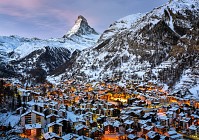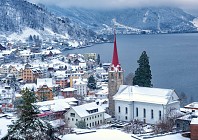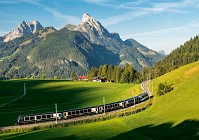Rather like one of her most celebrated natives, Roger Federer, Switzerland has a charming modest streak. She is the quintessential Alpine country; one with an unarticulated soul.
She is French without the shoulder-shrugging insouciance, German without the matter-of-factness, and Italian, but with impartiality. To get an authentic impression of Switzerland, the Canton of Jura in the north-west of the country has it all, and not just the freshness of air, the purity of water or the drama of mountains.
“Remembrance of things past is not necessarily the remembrance of things as they were,” said Marcel Proust at the dawn of the 20th century, and his words still ring true today.
I am 54 years old now and it’s an interesting age, one at which one looks as much backwards, to be informed, as forwards to embrace the new. Coming from a family of novelists, it is often hard to separate fact from fiction, so I set out to the Jura region with two goals in mind: to see where my family, the Jacots, used to live, and to discover more about the relatives I had always been told about as a child, as well as the land from which they are from.

FAMILY TIES
My first significant discovery was made just outside the city of Neuchâtel, during a chocolate- and wine-tasting tour at Jacot Chocolatier in Noiraigue, where scientists experiment to find the best combination of some 600 aromas from the cocoa beans of Madagascar, regarded as the best in the world. It was here, amid the rarefied and coffee-scented air, that I met one of two distant relatives in Switzerland; the other was in my home valley itself.
Later, in the library at the Musée International d’Horlogerie in La Chaux des Fonds, I found a rather impressive cast of characters linked by blood or a commercial partnership to my Jacot ancestors. I discovered that, as a result of inter-marriages over 300 years, the same 10 or 12 families within the valley became interlinked, forming a complex web of connections throughout the entire Jura region.
I discovered connections with several notable families originally based in the area, including the architect Le Corbusier (Charles-Édouard Jeanneret). His mother, Marie Charlotte Amélie Perret, was the daughter of Amélie Pingeon who was previously married to a Jacot and by whom she had three children. Le Corbusier designed the Villa Favre-Jacot in Le Locle, built for the highly successful watch and clock factory owner Georges Favre-Jacot, who founded Zenith Watches here in 1865.
The Joux Valley of the Canton of Jura is well-known for its watch-making heritage. The Swiss in the Jura region, who spent their summer farming dairy cows, found ways to keep themselves busy through the winter months via the painstaking art of watchmaking. The application, accuracy and precision involved in the creation of Swiss timepieces is a stunning tribute to mankind.
You can see the current productions from the main watchmaking houses of the area at the Espace Horloger in Sentier. The Joux Valley is the cradle of ‘grande complication’ watches, and the nearby towns of Le Locle and La Chaux-de-Fonds are also home
to some of the most famous Swiss brands, including that of my ancestor.
My final name drop is Frédéric Courvoisier (1730-1760) who married Suzanne-Marie Jacot and founded Courvoisier et Compagnie in La Chaux-de-Fonds in 1830. Known as Fritz Courvoisier, he was one of the principal instigators of the revolution of 1848 in Neuchâtel — part of a wave of political upheaval that spread across Europe that year.

SWISS HERITAGE
Family ties aside, I quickly discover there’s plenty more to lure the discerning aesthete to the Jura region. If travelling brings out an instinctive desire for orientation via maps, culture and museums, then a visit to La Chaux-de-Fonds is imperative.
Next door to the magical Musée International d’Horlogerie is the Musée des Beaux Arts, which, for a provincial collection, is impressive. There’s representation from virtually all the Impressionists, including a rather bizarre van Gogh portrait of a young boy with matted hair.
Then there is the curious CIMA Museum of the Music Boxes in Sainte-Croix, where Genevan clockmaker Antoine Favre-Salomon invented a musical pocket watch in 1796 and is thus considered to be the inventor of the music box, and Sainte-Croix the mechanical music capital of the world. Music automatons are still produced here and can cost as much as CHF 30,000 (US $31,500).
Outside the museums, the Jura district offers plenty of pursuits for outdoor, active types — with an endless list of activities including swimming in lakes, climbing, winter skiing and hiking through caves. Deep inside the Vallorbe Caves, the biggest in Jura, is a subterranean river creating a secret and enchanting world.
It’s a fairyland of strange concretions and immense vaults, formed by water with cascades, lakes, stalactites and stalagmites. The scene reminded me of Samuel Taylor Coleridge’s poem Kubla Khan: “Where Alph, the sacred river, ran through caverns measureless to man down to a sunless sea.”
Such pursuits are sure to build a thirst, so for a real appetite whetting, I recommend the nearby and brand-new Maison de l’Absinthe in Môtiers. Absinthe is obtained by distilling a blend of plants including grande wormwood, which comes exclusively from the Val-de-Travers, the historic origin of this mythical drink. Despite being banned for nearly a century, absinthe always survived here over the years. Its clandestine days are now over and it can be enjoyed legally.

Absinthe not to your taste? There’s always award-winning wines to be tasted at Château de Valeyres in Valeyres-sous-Rances, with owner Benjamin Morel. At his winery, Morel is breaking with usual Swiss conservatism by using egg-shaped barrels designed to aerate more effectively. Each barrel contains the equivalent of 200 bottles of wine. To sober up, there’s a nourishing option next door at the quaint La Vieille Auberge. Or for a more traditional lunch try the alpine Restaurant du Mont-de-Baulmes, with its own brand of Gruyère cheese batters.
If you’re keen to discover more of two of Switzerland’s greatest gourmet exports, come in high season and hop on board the first-class “Belle Epoque Pullman” carriages of the Chocolate Train, which, like all train services here, epitomise the Swiss: clean, punctual and stylish. It runs from Montreux to the Gruyère region from where the excellent Cailler chocolate and eponymous cheese come from.
Along your journey, you’ll get to see how Gruyère cheese is made at the dairy and get a behind-the-scenes look at chocolate production at the Cailler factory. The experience sums up Switzerland’s timeless appeal — whether you’ve family roots there or not, you’re sure to leave feeling a connection to the place.












